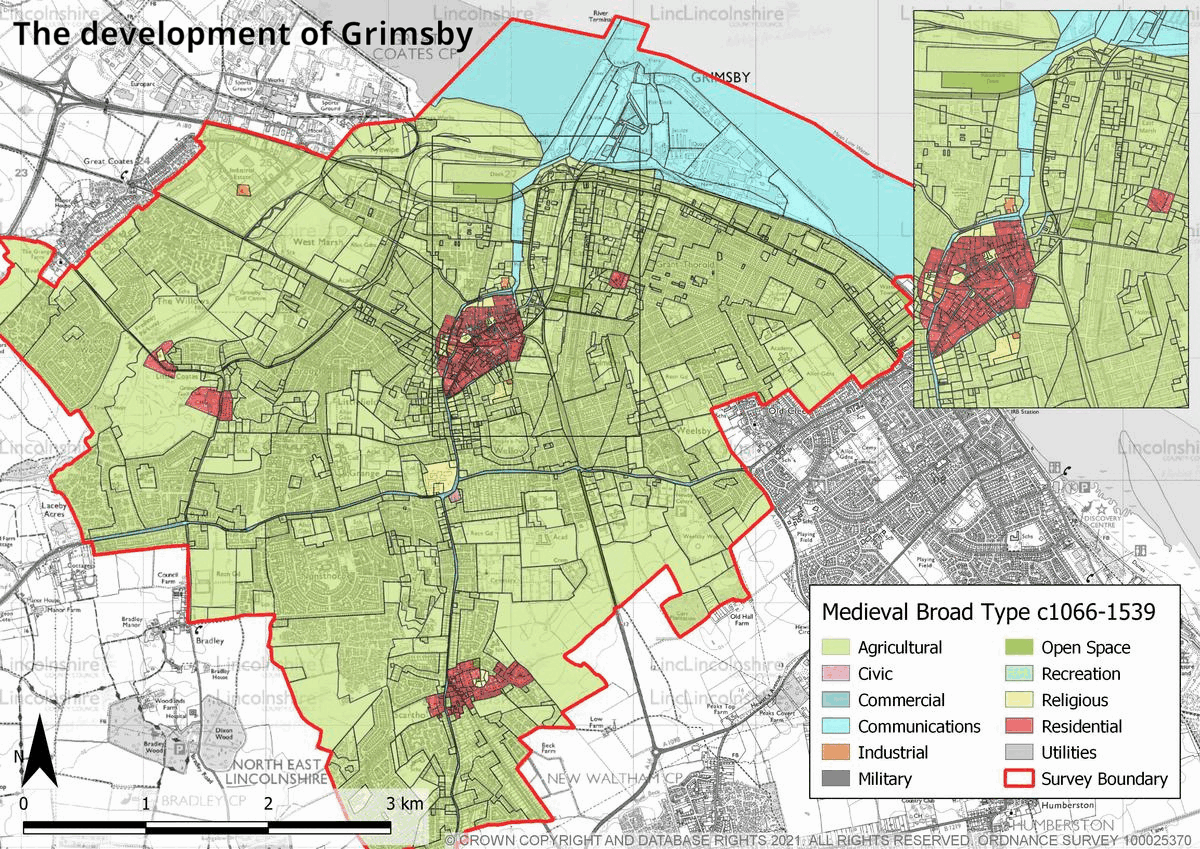GRIMSBY
Historic Background
Archaeological evidence relating to the prehistoric period is recorded across the survey area. Environmental remains provide context as to the natural environment during this time, which appears to have been fairly wooded. Prehistoric axes indicate that there could have been some degree of management of the local environment. Domestic remains show that there was long term occupation of the residential sites. The discovery of animal bones also demonstrate that livestock was being kept as part of the settlements. Evidence of iron working, including moulds for horse trappings are also included in the findings. Roman remains recorded within a number of the sites demonstrate that occupation continued after the Iron Age period.

There are varying legends around the establishment of Grimsby. One states that Grimsby was founded by a merchant named Grim who had fled Denmark with Haveloc, the son of King Gunter of Denmark. Upon arrival in Grimsby, his ship was so damaged that the timbers could only be used for building a small house. It was from this house that Grim is said to have sold fish and salt, and consequently established a farmstead which later grew into the settlement of Grimsby. The story of Grim and Haveloc is known from a retold 12th century romance by Geoffrey Gaimar, which is likely to have imposed later medieval ideals onto the earlier period in the narrative. A stone called Haveloc’s Stone marked the border between Grimsby and Wellow until the 19th century. The Domesday survey of 1086 recorded Grimsby as a town of growing prosperity and by 1194 Grimsby was given borough status, which granted the settlement increased rights and privileges. During this period Grimsby became home to multiple religious houses, including 2 friaries, an abbey, priory and a hospital.

By the 13th century, Grimsby had already reached a peak in its medieval prosperity and was beginning to decline, largely due to the Haven becoming clogged with slit. Efforts were made to clear the water course, including the construction of additional channels, however, these were largely unsuccessful. As a result, trade began to decline in the town as traders chose other settlements for their business. The town suffered a further blow during the religious reformation of the 16th century which led to the closure of the religious houses in the town, who had provided a great deal of trade. The town’s fortunes changed swiftly during the late 18th and early 19th century, as you can see here with the construction of a new dock on the Haven, this resulted in huge growth to the east of the Haven with an explosion of businesses, residential streets and industry.
The introduction of the railway in 1848 also resulted boosted the town’s economy, as it created effective transport from the sea to inland towns. During the late 19th and early 20th centuries, the town swelled into former marshland and absorbed several of the surrounding villages. It also developed its fishing fleet and became a national leader in the industry. Despite its success, concerns were raised that it had become a single industry town and that efforts must be made again to diversify. These concerns proved to be well founded as the industry suffered during the century and was severely impacted by the Cod Wars which restricted fishing rights. In the late 20th and early 21st centuries Grimsby has begun to diversify with new trades, including renewable energy.


Character Summary
Across the town of Grimsby the built and spatial form is widely varied. Periods of development were fueled by the changing prosperity in the town, with surges in the medieval period, the 19th century and the modern period. Heritage and assets from the medieval period are well represented across a number of character areas. The focus for the medieval town of Grimsby is in HUCA 1, although settlement cores are found across the survey area. The historic character of this HUCA is preserved in the street layout and property boundaries, some of which are preserved. Remodeling of the town centre occurred in the 18th, 19th and 20th century which has formed a diverse town centre with a variety of architectural styles. The 18th and 19th century development of the town is represented in HUCA 2, which was the first development to take place outside of the town centre during its revival. This area is characterised by early industrial, residential and commercial development, highlighting the renewed prosperity and aspirations for the town. Some of this early construction has been remodelled in the 20th and 21st centuries. Character Areas 3, 4, 5 and 9 were developed in the mid-late 19th century as the town experienced exponential growth. Residential areas were developed in 3, 4 and 5 although industry and industrial buildings were still common throughout. HUCA 9 was developed as the new dock area which dominated the town’s fishing economy during this period and into the 20th century.




Character Areas 6, 7, 8 and 10 were developed throughout the 20th century as the town expanded into new areas. These are predominantly residential, although schools, industry, and areas of commerce were also established as part of large single developments. The HUCAs are also located on the site of early settlements from the early medieval and medieval periods, although these have been absorbed into the later town of Grimsby. The dominance of brick as a cheap and efficient building material is obvious across the survey area with some high-status buildings, such as churches and banks using stone. The role that industry had in the town’s development is also immediately obvious, creating a repeated character across the survey area, which is unique to Grimsby.


